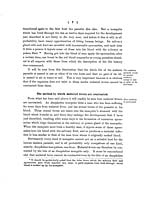Medicine - Disease > Malarial fevers
(14) Page 8
Download files
Individual page:
Thumbnail gallery: Grid view | List view

(8)
mosquito, unless that mosquito has sporozoites in its salivary glands. This
means that it must have bitten a man with malarial fever a week or more
previously, and that the temperature and other factors necessary for the
development of the parasites in the mosquito's body, were favourable.
Again it is not sufficient for an Anopheline mosquito to have bitten a man
with malarial fever unless sexual forms of the parasite (which alone can
develop in the mosquito) were present in the man's blood at the time he was
bitten, and in addition the sexual forms must have been fully developed, for,
as a general rule, sexual forms cannot proceed to further development even
in an Anopheline unless they have reached a certain stage of maturity. Thus
in order that an Anopheline mosquito may be able to carry infection it must
have previously bitten a malarial fever patient at a particular period of his
case.
In malarious places, however, cases of malarial fever are so frequent, and
the number of Anopheline mosquitoes is so great, that many opportunities
occur for all the required conditions to be fulfilled, so that it is always
possible in malarious places to find a number of Anopheline mosquitoes with
sporozoites in their salivary glands.
Recapitula-
tion of the
chief facts.
The most important facts which we have learnt so far may be summed
up as follows:-
(1) Malarial fevers are caused by the presence in the blood of the
patients of a small parasitic animal belonging to the lowest grade
of the animal kingdom, the PROTOZOA.
(2) This parasite passes its life in two hosts, viz., man and Anopheline
mosquitoes.
(3) In man it multiplies itself by a process of simple division for some
time, and then produces sexual forms, which for their further
development require to be taken into the body of the second
host which is an Anopheline mosquito.
(4) This is effected when such a mosquito bites a man with those forms
in his blood.
(5) In the mosquito's body the female sexual form is fertilized by the
male, the cell which results being called a zygote. By the growth
and division of the zygote an enormous number of new forms of
mosquito, unless that mosquito has sporozoites in its salivary glands. This
means that it must have bitten a man with malarial fever a week or more
previously, and that the temperature and other factors necessary for the
development of the parasites in the mosquito's body, were favourable.
Again it is not sufficient for an Anopheline mosquito to have bitten a man
with malarial fever unless sexual forms of the parasite (which alone can
develop in the mosquito) were present in the man's blood at the time he was
bitten, and in addition the sexual forms must have been fully developed, for,
as a general rule, sexual forms cannot proceed to further development even
in an Anopheline unless they have reached a certain stage of maturity. Thus
in order that an Anopheline mosquito may be able to carry infection it must
have previously bitten a malarial fever patient at a particular period of his
case.
In malarious places, however, cases of malarial fever are so frequent, and
the number of Anopheline mosquitoes is so great, that many opportunities
occur for all the required conditions to be fulfilled, so that it is always
possible in malarious places to find a number of Anopheline mosquitoes with
sporozoites in their salivary glands.
Recapitula-
tion of the
chief facts.
The most important facts which we have learnt so far may be summed
up as follows:-
(1) Malarial fevers are caused by the presence in the blood of the
patients of a small parasitic animal belonging to the lowest grade
of the animal kingdom, the PROTOZOA.
(2) This parasite passes its life in two hosts, viz., man and Anopheline
mosquitoes.
(3) In man it multiplies itself by a process of simple division for some
time, and then produces sexual forms, which for their further
development require to be taken into the body of the second
host which is an Anopheline mosquito.
(4) This is effected when such a mosquito bites a man with those forms
in his blood.
(5) In the mosquito's body the female sexual form is fertilized by the
male, the cell which results being called a zygote. By the growth
and division of the zygote an enormous number of new forms of
Set display mode to: Large image | Zoom image | Transcription
Images and transcriptions on this page, including medium image downloads, may be used under the Creative Commons Attribution 4.0 International Licence unless otherwise stated. ![]()
| India Papers > Medicine - Disease > Malarial fevers > (14) Page 8 |
|---|
| Permanent URL | https://digital.nls.uk/74558878 |
|---|




